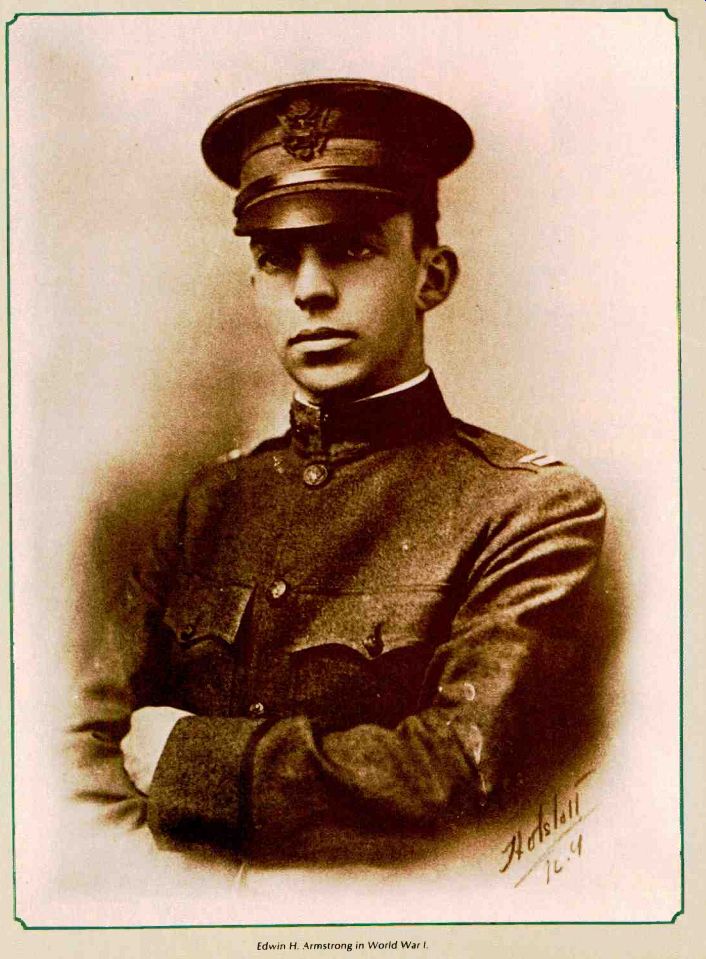
By Gary Stock
Sophocles or Shakespeare would have made a superb drama of the story. A 22-year-old inventor of patrician breeding develops one of the most important new ideas of his time. Wealth, fame, and influence all come to him as he develops other similarly fundamental inventions which influence many segments of his society. But as his ideas become more and more valuable, he is enmeshed in legal difficulties against powerful corporate interests until finally, in the autumn of his life, worn down by constant legal struggle and acrimony, he takes his life in a leap from a tall building.
Unfortunately, both Sophocles and Shakespeare lived too early to observe the grand story of Edwin Howard Armstrong, born in 1890, who developed three inventions that changed our lives, the feedback circuit and the superheterodyne principle that, individually or in combination, form the basis of almost all modern radio and radar communications, and FM radio itself, which first brought high-fidelity music to millions and spurred the development of home audio components. It has been said that Armstrong's extraordinary contribution to technology was as great as that of Marconi, the Italian inventor of AM radio, or even Edison.
Edwin Armstrong grew up in the straight-laced eighteen-nineties and first years of this century. His family, like many other prominent families of the time, was involved in the business of business. From an early age Edwin was fascinated by electronics--not the electronics of huge dynamos and power plants--but the ghostlike electrical currents of "wireless," the dot-and-dash radiotelegraph communication of the day. Except during laboratory experiments, there was no such thing as voice or music transmission by radio; he would later make it possible.
Armstrong converted the attic in his family's Yonkers home into a radio lab filled with the ponderous primitive equipment of the day, huge foil-lined glass jars, outsized wire coils, and long antenna leads. The huge tower antennas typical of the time were necessary simply because the radio receivers were so insensitive and required such large input signals. Radio operators had to wear viselike headphones and hold their breath while listening for messages, and most long-distance communication was conducted at night when the faint static generated by the sun was not present. Every additional foot of antenna height was valuable in collecting the quantities of radio-frequency energy needed by early receivers.
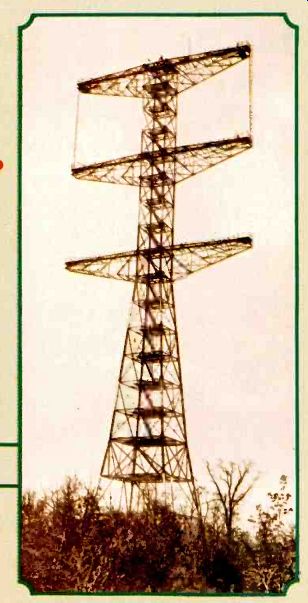
------- The 400-foot broadcasting tower constructed by Armstrong on the Hudson
River Palisades in Alpine, New Jersey.
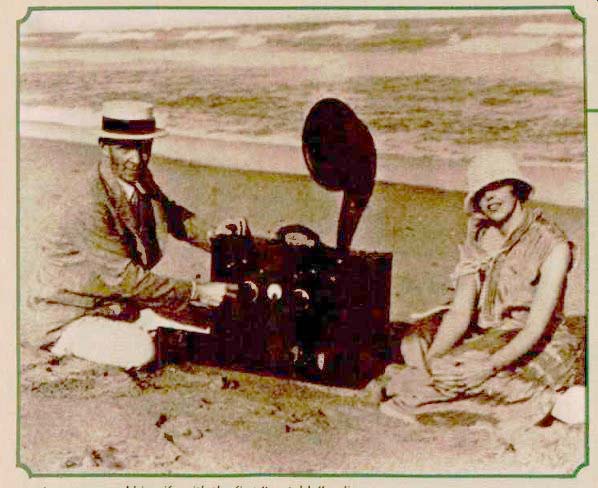
--------- Armstrong and his wife with the while on their honeymoon
in Florida.
By the time Armstrong went off to Columbia University in 1909 to earn his degree in electrical engineering, he knew more about the history of electronic developments and more about esoteric points of theory than many of his professors. Beyond this, however, he had an intuitive understanding of the movement and flow of electricity in circuits, derived from thousands of experiments. It was this seat-of-the-pants understanding of electronic circuits that brought Armstrong to the first of his major inventions in 1912.
Late in the summer of that year, just before returning to finish his senior year at Columbia, an idea occurred to him while on vacation in the Vermont mountains. The idea, which is now used in virtually every television, radio, and radar in existence, was to send part of the radio signal that arrived from the antenna in a loop, or "wing" as he called it in his notes, back to the beginning of the circuit after it had reached the end. When properly done, this re-amplified the incoming radio signal again and again with each movement of the electrons through the loop. The principle, for obvious reasons, he called regeneration, al though the more literal term "feed back" is now commonly used. The effect of this arrangement on his home made radio receiver was astounding.
Radio stations in Ireland, Nova Scotia, and Europe which had been lost in static emerged from the headphones with complete clarity. Many local stations were suddenly so strong that he could no Monger bear to wear head phones, and he listened to their signals from across the room with the phones lying on a table. In his attic in Yonkers, as an undergraduate student in engineering, Armstrong had built the world's best radio, and redefined the basic principles of radio reception. He would also find during the next couple of years that feedback could be used to develop a new type of transmitter, capable of bringing the spoken voice and music over the airwaves for the first time.
Armstrong's father, a solid Republican sort, didn't see the potential impact of his son's experiments, however, and refused his son the $150 then needed for a patent application. After a hurried and unsuccessful canvass of friends, who were just as broke, Armstrong settled for having his lab sketches notarized and dated. Finally, a few months after his graduation, he applied for a patent on regeneration. It was issued in 1914, just after the be ginning of the First World War.
America did not become directly involved in the War for another three years, and during this period Armstrong's fame began to spread. Use of his feedback circuit became de rigueur on the amateur radio set, and rights to various aspects of his patent were bought up by American Marconi. But American Telephone and Telegraph also began to use the circuit for long distance telephone communications, without paying royalties to Armstrong, and backed in a court action an inventor who claimed to have made essentially the same invention. It was to be the first of many legal battles for Armstrong.
The entry of the United States into the war in 1917 took him from the world of patents and inventor's claims to France. Predictably, he became a member of the Signal Corps, and spent most of the war rebuilding allied radio sets to use the feedback circuit. In Par is, just before the end of the war, Armstrong, then 28, made his second great invention. It was called the superheterodyne circuit, and unlike feedback, it is a development of such subtlety that it defies easy description in lay man's terms. Radio waves consist of electrical currents which vary rapidly; the exact number of variations per second is called their "frequency." These variations are unimaginably rapid to us. In 1917, radio engineers had learned how to construct transmitters and receivers capable of working with frequencies up to about 1,000,000 cycles, but above that they could not produce reliable results. The superheterodyne circuit was an arrangement by which very high frequency radio signals could be transformed into more easily handled lower frequency signals. This was accomplished by mixing the incoming radio signal with a second signal generated inside the receiver that differed slightly in frequency.
The mixing produced a signal that was precisely the arithmetic difference be tween the other two, which in effect subtracted one wave from another, thus producing a third that could easily be processed and amplified. This development is found, in one form or another, in almost every broadcast reception device available today.
At the end of the war, decorated by the Allied governments for his assistance in improving field communications, Armstrong returned to New York, carrying the superheterodyne circuit in his head. At that time, rights to inventions developed by Army personnel could be retained by the inventor and sold. In short order, Armstrong did just that, selling commercial rights to both the feedback and the superhet patents to Westinghouse for a huge sum. He also defeated his opponent AT&T in the first court battle, and sold a refinement of the feedback principle called super-regeneration to the newly formed Radio Corporation of America for another six-figure sum, plus 60,000 shares of RCA stock. Armstrong was all at once a wealthy man, young, full of new ideas, a celebrity living in the roaring twenties, the dawn of radio's golden age. He had, by the age of 30, accomplished the American dream in most every particular.
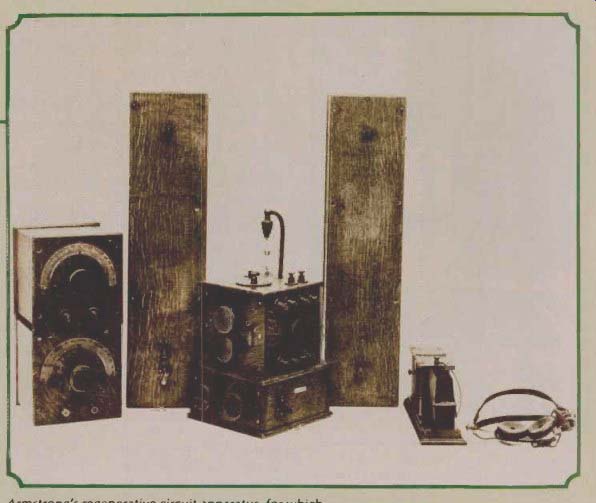
------------Armstrong's regenerative circuit apparatus, for which he was issued
a patent in 1914.
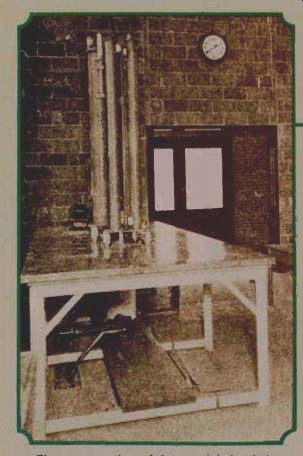
--------- The construction of the coaxial circuit (on the table) for r.f.
power amplifiers at station W2XMN.
Armstrong fell in love, as young men of every era are wont to do. She was a tall, attractive secretary to RCA's legendary David Sarnoff, at that time Armstrong's friend. He approached her with the irresistible force of a successful entrepreneur accustomed to achieving his objectives. "How would you like to take a drive in a fast foreign car?" he asked her. "I'm leaving for France on a vacation tomorrow and I intend to buy the biggest and most ex pensive car I can find to bring back." He returned with one of the most exotic cars of the era--a magnificent fawn-colored Hispano-Suiza touring car, with which he courted Miss Marion MacInnis through the spring and summer of 1923. They were married in the winter of that year and honey mooned, in the style of the times, by driving the Hispano-Suiza to Florida. It was certainly one of the happiest years of Armstrong's life, and the last before the legal struggles enveloped him.
The AT&T-backed inventor Armstrong had beaten in court on his re turn from the First World War was Lee DeForest, a man justly renowned for the audion tube, an important building block in early electronics, but one also known for the formation of dozens of short-lived and ultimately bankrupt companies. DeForest, backed again by AT&T and later by RCA, fought a shrewd battle through the twenties to gain control of almost all of Armstrong's patents. Attacking again and again in different suits, he finally found a favorable issue for one suit, won a decision, and parlayed that decision into a stunning Supreme Court victory over Armstrong in 1934.
It was one of the longest and most complex patent actions in American history, all the more extraordinary be cause virtually the entire scientific community as well as the !lower courts rejected DeForest's contentions as clearly and obviously incorrect in the technical sense. When Armstrong, at a convention of the Institute of Radio Engineers, attempted to return the awards given him by the iRE for the developments, a unanimous motion of the membership reaffirmed his rights to the awards and requested that he keep them. But in the legal sense, and in much of the popular press, Armstrong had become a discredited inventor, with no right to take credit for radio's development.
But Major Armstrong, as he had come to be called because of his former Signal Corps rank, had one great idea left. Throughout the long le gal fight with DeForest, he had continued his laboratory research, searching, as were many engineers of the day, for a solution to the problem of static in radio reception.
Static is the electrical byproduct of natural events such as lightning and sunspot flare-ups, and to thus day al! AM radio reception is afflicted with it, since such natural events amplitude modulate the airwaves just as an AM radio transmitter does. Any radio receiver designed to pick up conventional AM radio signals must also pick up random natural electrical events and translate them into static. After 10 years of work, Armstrong had concluded that there simply was no way around this fact. The only means to achieve static-free radio reception was to change the way in which radio signals were broadcast and received so that natural events could not interfere with them. One way of doing this was to broadcast a radio signal in which the signal's frequency, rather than its amplitude, was constantly varied; this was FM (Frequency Modulated) radio. Between 1930 and 1933, Armstrong, now wiser about legal questions, filed a series of seemingly airtight patents which he believed gave him undeniable rights to FM broadcasting.
FM, however, would require both new transmitters and new receivers; neither broadcasters nor the public would want to buy one element un less the other were in place, a chicken and-egg situation that could be re solved only by the formation of an FM network. Armstrong approached his old friend Sarnoff at RCA, which con trolled the NBC radio network, and proposed the new system. For two years RCA conducted studies, asked for more information, and generally delayed decision on the issue. At one point Armstrong approached Sarnoff for an explanation of the delay. "There is a depression on," noted Armstrong, "and the radio industry needs some thing to put life in it. I think this is it." Sarnoff replied, "This is not an ordinary invention. This is a revolution." Sarnoff, the immensely successful businessman and corporate tactician, apparently realized that the higher fidelity of FM and the vast number of new stations it would require might lead to a complete, and for RCA per haps devastating, restructuring of the broadcasting business. For these reasons, and because in 1935 he was about to commission a wholesale corporate effort to develop television, Sarnoff saw no benefit to RCA in developing FM radio rapidly.
Left with no other option, Armstrong, now modestly wealthy but still a single, private individual, set out to commercially develop FM radio him self. He constructed a 400-foot broad casting tower, which still stands on the Hudson River Palisades, and, after licensing a handful of other experimental stations to broadcast in FM, took to the airwaves himself. The first broad casts proved false the rumors that FM wouldn't work. The quality of reception from his experimental station was beyond anything that had ever been heard on AM radio. Technically, Armstrong's station W2XMN had a wider band, lower noise, and lower distortion than any AM station in history and was static-free as well. Some 40 other FM stations, mostly small independent affairs with a few owned by large companies like General Electric, quickly sprang up, despite maneuvering by the broadcast giants in Washington to have FM's broadcast band limited, thus reducing the number of FM stations capable of operating in any given area to five. Even RCA set up an FM station. It appeared that the new method of broadcasting was be coming established.
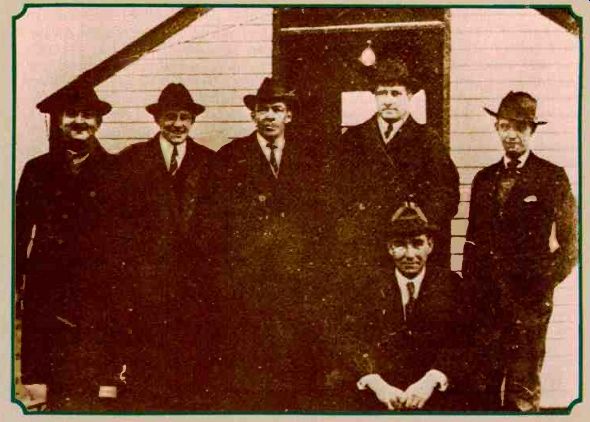
--------- Posing outside the transmitter house after sending a message
to Scotland were (left to right) John L. Grinan, Ernest V. Amy, Armstrong,
George E. Burhard, Minton Cronkhite, and (seated) Walker P. Inman.
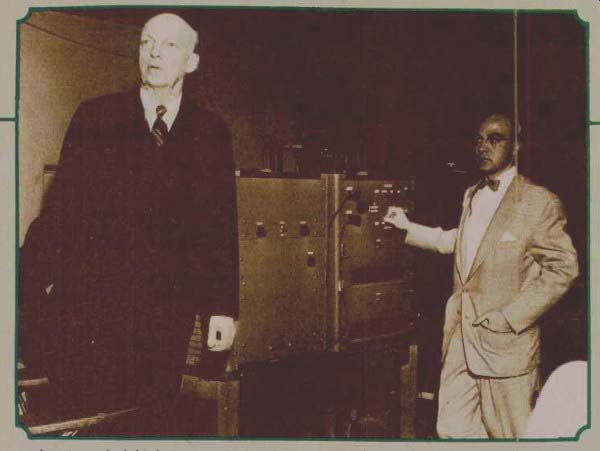
---------- Armstrong (at left) during a multiplexed transmission demonstration.
The Second World War intervened, however, bringing to a halt all work on new broadcasting projects, and reducing Armstrong's income enormously, since he made his patents available royalty-free to the government for military purposes. At the end of the war, Armstrong expected to pick up where he had left off and establish a commercially successful FM broadcasting industry. But a series of FCC decisions, advocated by the major broadcasting networks, dealt Armstrong and FM two telling blows. One moved FM from its old band to the present 88 to 108 megaHertz band, instantly rendering obsolete every FM transmitter and receiver in existence. The other cut back the maximum transmitter power of most FM stations. Armstrong spent the next two years attempting to re cover from these decisions and to put FM back on the track.
All of the frustrations of his battles with the major broadcasters and radio manufacturers finally brought Armstrong, in 1948, to tile a lawsuit against RCA and its subsidiary NBC for patent infringement on his FM broad casting system. Every television set manufactured by RCA (and, for that matter, by anyone else) used FM for its sound channel, and RCA had also been manufacturing FM radios and, incredibly, licensing FM rights for several years. Armstrong sought to recover damages on TV sets made by RCA and its licensees and thereby achieve some measure of repayment for the long struggle over FM broadcasting.
This suit was to be his last battle, how ever. RCA's attorneys, taking advantage of the complexities of patent law, kept him on the witness stand for a full year, going over and over every detail of his invention of FM. After the courts finally cut off this interrogation, Armstrong's attorneys spent an additional two years examining every RCA record pertaining to FM--a monumental quantity of paper. Throughout this period, RCA held fast to its claim that Armstrong had only refined certain FM principles, and that most of the real work on bringing FM to commercial fruition had been done in RCA laboratories. On' the witness stand, RCA Chairman Sarnoff stated that RCA and NBC had done more to make FM a reality than anyone else, including Armstrong, a statement which killed any remaining affection Armstrong might have felt for his former friend.
During this period Armstrong devoted every waking hour to the trial, driving himself to exhaustion. And, toward the end of this period, he and his wife Marion separated, she to live for a while in Connecticut with a sister. The strain of being denied recognition of development of FM, as previously with feedback and the superheterodyne circuit, combined with the stress in his personal life finally proved too much for Armstrong. On a Sunday night in the late winter of 1954, he stepped out the window of his apartment 13 stories above Manhattan.
Ironically, his estate was ultimately victorious in each of the suits that had been filed against RCA and its licensees, settling most by agreement. And the verdict of history, as represented by The Edison Medal. The Franklin Medal, and his inclusion among the 20 Great Men of the Union Internationale des Telecommunications, is clearly that he was the developer of all three of the devices in question and a world-class inventor on the scale of Bell or Whitney.
Armstrong, it might reasonably be argued, was among the last of the great individual American inventors, a breed presently reduced in rank or perhaps extinct, in a period during which vast corporations came to dominate virtually all scientific and techno logical development in this country.
The Armstrong story would indeed make a superb play, al' the more significant because the story is true. A ;Vote: Edwin Armstrong's biography, from which this article is in part derived, is called Man of High Fidelity and is by Lawrence Lensing. It is avail able from The Armstrong Foundation, Columbia University, New York, New York 10022. Price: $2.00.
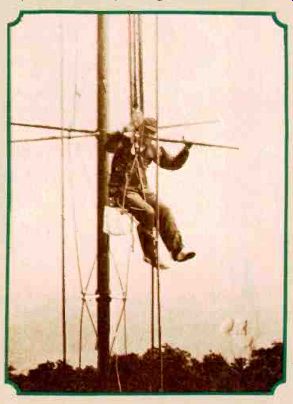
-------- Armstrong on his broadcasting tower in Alpine, New Jersey during
is construction.
(adapted from Audio magazine, Nov. 1980)
Also see:
PROFILE---Paul Klipsch Arkansas Speaker Maker (Aug. 1980)
= = = =